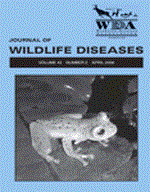The collection of blood samples for serological studies is often stressful for the focus animal. Recently, the use of bloodsucking bugs, such as Dipetalogaster maximus or Triatoma infestans (Reduviidae; Triatominae; Heteroptera), has been suggested as a new and less invasive method for blood collection. To evaluate this technique, we collected paired blood samples from 20 domestic rabbits (Oryctolagus cuniculus) during a study of rabbit hemorrhagic disease virus (RHDV). For each rabbit, blood samples were collected by the conventional method (needle and syringe from the vena auricularis) and through feeding by D. maximus. Samples were tested for RHDV antibodies using standard test kits at three different dilutions. Antibody titers were identical for 56 paired samples and differed in only four cases. The simple matching indices were 1 for the 1:10 dilution and 0.9 for the 1:100 and 1:1000 dilutions. The major advantages of the new technique are 1) the possibility to obtain blood from animals where veins are inaccessible and 2) the fact that anesthesia of focus animals may not be necessary.
How to translate text using browser tools
1 April 2006
An Alternative, Less Invasive Blood Sample Collection Technique for Serologic Studies Utilizing Triatomine Bugs (Heteroptera; Insecta)
Christian C. Voigt,
Ulrike Peschel,
Gudrun Wibbelt,
Kai Frölich

Journal of Wildlife Diseases
Vol. 42 • No. 2
April 2006
Vol. 42 • No. 2
April 2006
Dipetalogaster maximus
non-invasive blood sampling
serology
stress




